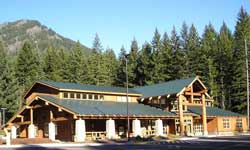The Forest Service uses a wide variety of buildings to help
accomplish its mission. Offices, warehouses, research laboratories,
visitor centers, houses, dormitories, and shower buildings are
a few of the buildings the public might see in our National Forests.
Many buildings are small, but some of the research laboratories
and visitor centers we build are quite large. Though we construct
only a few buildings each year, several of our buildings are
on the National Register of Historic Places. Many of these buildings
date from the early days of settlement in the western parts of
the United States; others were built by members of the Civilian
Conservation Corps (CCC) over 50 years ago. If buildings were
people, one of every three Forest Service buildings could qualify
for retirement!
Renewable energy technology is used wherever it is cost-effective.
For example, solar hot water heating and photovoltaic panels
are being used more than ever before to help reduce costs and
to save nonrenewable energy sources.
Today's facilities engineers continue to uphold a long-standing
Forest Service tradition of efficient, durable, ecologically
responsible development. |
| |
Example of a newer building
Demonstrating the Forest Service commitment to progressive
engineering, all new Forest Service offices over 2500 square
feet in size are certified at the silver level of the LEED green
building rating system. The Detroit Ranger Station
office of the Willamette National Forest (Oregon) in the
Pacific Northwest Region, shown at right, is an example
of a structure that fits its setting in the foothills of
the Cascade Mountains and incorporates sustainable design
features. For example, the clerestory windows provide
plenty of daylight to the offices, so that electric lighting
is not needed on many days.
|
 |
|
| |
Example of an historic facility
The Ranger's Office building at the Tellico Ranger Station
of the Cherokee National Forest (Tennessee) in the Southern
Region, shown at right, is part of a completely preserved
Civilian Conservation Corps period (1933-1942) complex. It
was rehabilitated in 1996. Tellico is a working Ranger
Station that is eligible for listing on the National
Register of Historic Places. |
 |
|
 |
Facilities-related
documents:
|
|